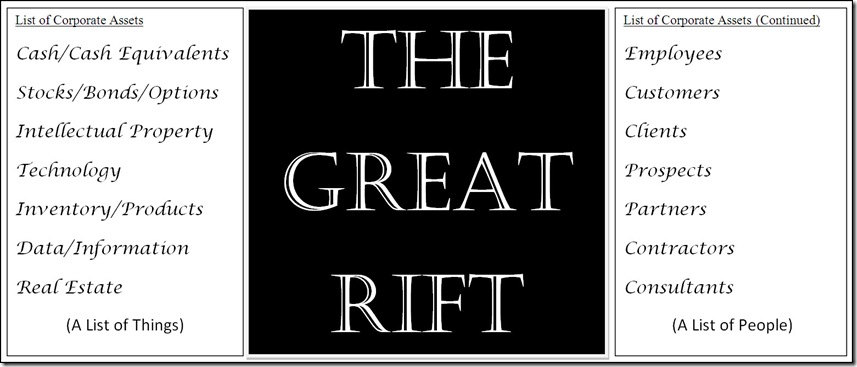The Great Rift
/I recently read a great article about social collaboration in the enterprise by Julie Hunt, which includes the excellent insight:
“Most enterprises have failed to engender a ‘collaboration culture’ based on real human interaction. The executive management of many companies does not even understand what a ‘collaboration culture’ is. Frankly, executive management of many companies is hard put to authentically value employees—these companies want to de-humanize employees with such terms as ‘resources’ and ‘human capital’, and think that it is enough if they sling around a few ‘mission statements’ claiming that they ‘value’ employees.”
Even though the article was specifically discussing the reason why companies struggle to effectively use social media in business, it reminded me of the reason that many enterprise initiatives struggle—if not fail—to live up to their rather lofty expectations.
The most common root cause for the failure of enterprise initiatives is what I like to refer to as The Great Rift.
The Great Rift
In astronomy, the Great Rift—also known as the Dark Rift—is a series of overlapping and non-luminous molecular dust clouds, which appear to create a dark divide in the otherwise bright band of stars and other luminous objects comprising our Milky Way.
Within the intergalactic empires of the business world, The Great Rift is a metaphor for the dark divide separating how most of these organizations would list and prioritize their corporate assets:
Please note that a list of things is on the left side of The Great Rift and on the right side is a list of people.
Although the order of importance given to the items within each of these lists is debatable, I would argue what is not debatable is that the list of things is what most organizations prioritize as their most important corporate assets.
It is precisely this prioritization of the value of things over the value of people that creates and sustains The Great Rift.
Of course, the message delivered by corporate mission statements, employee rallies, and customer conferences would lead you to believe the exact opposite is true—and in fairness, some organizations do prioritize the value of people over the value of things.
However, the harsh reality of the business world is that the message “we value our people” is often only a Machiavellian illusion.
I believe that as long as The Great Rift exists, then no enterprise initiative can be successful—or remain successful for very long.
The enterprise-wide communication and collaboration that is so critical to achieving and sustaining success on initiatives such as Master Data Management (MDM) and Data Governance, can definitely not escape the effects of The Great Rift.
Eventually, The Great Rift becomes the enterprise equivalent of a black hole, where not even the light shining from your very brightest stars will be able to escape its gravitational pull.
“Returning to the human side of business won’t happen magically,” Julie Hunt concluded her article. “It will take real work and real commitment, from the executive level through all levels of management and employee departments.”
I wholeheartedly agree with Julie and will therefore conclude this blog post by paraphrasing the lyrics from “Yellow” by Coldplay into a song I am simply calling “People” because repairing The Great Rift and “returning to the human side of business” can only be accomplished by acknowledging that every organization’s truly most important corporate asset is—their people.
Rumors have it that the The Rolling Forecasts might even add the song to their playlist for the Data Rock Star World Tour 2010.
People
Look at your people
Look how they shine for you
And in everything they do
Yeah, they’re all stars
They came along
They wrote a song for you
About all the Things they do
And it was called People
So they each took their turn
And sung about all the things they’ve done
And it was all for you
Your business
Oh yeah, your technology and your data too
They turned it all into something beautiful
Did you know they did it for you?
They did it all for you
Now what are you going to do for them?
They crossed The Great Rift
They jumped across for you
Because all the things you do
Are all done by your people
Look at your stars
Look how they shine
And in everything they do
Look how they shine for you
They crossed the line
The imaginary line drawn by you
Oh what a wonderful thing to do
And it was all for you
Your business
Oh yeah, your technology and your data too
They turned it all into something beautiful
Did you know they did it for you?
They did it all for you
Now what are you going to do for them?
Look at your people, they’re your stars, it’s true
Look how they shine
And in everything they do
Look how they shine for you
Look at your people
Look at your stars
Look how they shine
And in everything they do
Look how they shine for you
Now what are you going to do for them?



